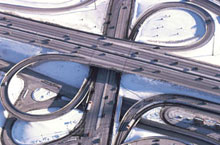In the U.S., infrastructure is usually silent and forgotten — until the power goes off, the ATM stops working or a neighborhood is consumed by fire. In September, for reasons still unknown, a 54-year-old gas pipeline blew up in San Bruno, Calif., killing eight people and damaging or destroying more than 50 homes. Seven weeks earlier, a 41-year-old oil pipeline ruptured in Michigan and spilled more than a million gallons of crude into a tributary of the Kalamazoo River. After a catastrophe, questions fly: How could this happen? Why wasn’t the equipment upgraded? What if things keep falling apart?
Tragedies such as the ones in California and Michigan also raise a broader question, says Erwann Michel-Kerjan, managing director of Wharton’s Risk Management and Decision Processes Center. “Is America ready for the 21st century?” he asks. “The answer is no.”
Most experts agree that America’s infrastructure needs an upgrade. Some say it needs a complete re-think. More than half of America’s natural gas transmission pipelines were installed before 1970, government data show; the same holds true for pipelines that carry hazardous liquids such as gasoline, diesel and jet fuel. And pipelines are just a fraction of the nation’s vast tangle of infrastructure — the roads, cables, wires, conduits, drains, satellites and switches that enable the flow of everything from sewage to Facebook posts.
Once a world leader in new technologies and infrastructure, the United States now finds itself behind the curve, experts say. Meanwhile, countries like China are building new airports, interstate highways, high-speed train lines and state-of-the-art telecommunications networks. “We’re losing our competitive power,” warns Michel-Kerjan. “The big picture is that we invested massively 50 years ago and more or less haven’t done anything of comparable magnitude since.”
According to Michel-Kerjan and other experts, infrastructure is a huge market that holds tremendous business opportunities, but the bulk of entrepreneurs and investors still wait on the sidelines because the projects are costly, complicated and often fraught with risk.
“At the end of the day, the whole discussion begins and ends with: How do we finance this?” says Lesa Mitchell, vice president of advancing innovation at the Kauffman Foundation. “I’m confident that … somebody is going to come along and figure out the for-profit angle. But [right now,] the only people at the table are big government and big companies…. One would hope that the more one [can shed light on] the topic, people who have an entrepreneurial bent will see the opportunity. But if we don’t [act] soon, we’re going to be in a world of hurt.”
Who Owns What?
One challenge lies in ownership issues. The 2.5 million miles of pipeline that snake throughout America’s cities, for example, are operated by about 3,000 different companies. In a book about the infrastructure crisis, Seeds of Disaster, Roots of Response, Michel-Kerjan points out that less than 20% of the nation’s infrastructure is publicly owned. “Conventional wisdom tells you that these systems are the responsibility of the government,” he says, “but in America at least, about 80% to 85% is run or operated by the private sector.”
Companies focused on the short term may tend to squeeze profit out of existing systems rather than finance system-wide upgrades. This can be especially true if the risk of infrastructure failure seems remote. “These are low-probability events, and it’s easy to say, ‘This isn’t going to happen to me,'” says Wharton public policy and management professor Howard Kunreuther, a co-director at the Risk Management Center. Most people suffer from an “incredible myopia” when it comes to planning for the long term or worst-case scenarios, he notes. When things are “out of sight, out of mind,” the tendency is to ignore the problem until a crisis hits. “There’s a general lesson from pipeline explosions or any kind of catastrophic event: When the event occurs, everyone pays great attention … but then [the problem] disappears.”
For private companies, there is also a rational component to favoring periodic maintenance over system-wide upgrades, Kunreuther points out. Funneling money into upgrading an entire system could strain business in the short term if competitors aren’t making the same capital-intensive investments.
Meanwhile, America’s government-run infrastructure — roads, bridges, rail and mass transit — is under severe financial strain because maintenance costs have increased faster than tax revenues. A February 2009 report from the National Surface Transportation Infrastructure Financing Commission warned that without policy changes, state and local governments would raise only about a third of the $200 billion needed each year to maintain and improve the nation’s roads and transit systems.
That’s a huge problem for the country’s economic future, given that about 75% to 80% of the value of freight in the U.S. is moved by truck, says business and public policy professor W. Bruce Allen. “If the highways are in bad shape, we’re in trouble.” In contrast, both China and India are building new seaports, airports and highways. As their transportation infrastructure improves, their export costs will go down, Allen adds. “The better they get at that, the lower their costs are going to be. I think that’s a huge problem. Our infrastructure is going in the other direction. It’s debilitating.”
In September, the Obama Administration proposed a program to revitalize the nation’s infrastructure by establishing an infrastructure bank and pledging $50 billion to rebuild 150,000 miles of roads, 4,000 miles of rail and 150 miles of runways. That’s on top of billions in stimulus money already allocated to infrastructure projects.
But don’t expect federal expenditures to translate immediately into pothole repair, cautions Wharton finance and economics professor Robert Inman. “The states are the guys who spend the moneys on highways, not the federal government,” he notes. And with most states struggling to balance their budgets, much of the stimulus money tagged for roads or bridges could get sidelined for several months or even years before finally being allocated to an infrastructure project.
Economists vs. Engineers
It’s also possible that some of our infrastructure shouldn’t be repaired, Inman suggests. An oft-quoted estimate from The American Society of Civil Engineers puts the price tag of upgrading America’s infrastructure at a staggering $2.2 trillion over five years. Inman believes that’s the viewpoint of engineers, who simply count all the bridges, roads and railways in the country and then tally how much it would cost to make them brand new.
An economist, on the other hand, would weigh not only the costs, but also the benefits of infrastructure repair. Take the example of a deteriorating bridge. An engineer might say it would cost $10 million to replace. “From an economist’s point of view, you want to ask, ‘Has anybody driven over this bridge in the last 10 years?’ What are the benefits of spending the money? It might be just as wise to let things fall apart if they’re not being used.”
Likewise, parts of the system that are being overused might need not only an upgrade, but also an expansion. Andrew E. Huemmler, a 20-year electric industry veteran and now a lecturer in electrical systems engineering and earth and environmental science at the University of Pennsylvania, says the nation’s electricity grid is “a third-world electricity system that really needs to be upgraded, but it still works pretty well, even with really old equipment.” He contrasts that with the network of natural gas pipelines, which is now under increasing strain as more of the country’s electric generation shifts from coal to natural gas. In one case, system operators in a New England town that converted to natural gas found themselves in a quandary when energy demand peaked: Should they temporarily turn off the heat or turn off the lights? “Everybody is building these new natural gas-fired plants,” says Huemmler, who was a moderator at Wharton’s recent energy conference titled, Energy’s Future: Bridging the Gap. “That puts a tremendous stress on the pipeline system.”
Others say it is time to completely redesign the country’s infrastructure for modern times. In Crossing the Energy Divide: Moving from Fossil Fuel Dependence to a Clean-Energy Future, brothers Robert Ayres and Edward Ayres argue that the U.S. could increase energy efficiency and spur economic growth by reforming its power infrastructure. One of the strategies offered in the book is combining heat and power. According to Robert Ayres, when producing electricity with fossil fuels, two-thirds of the energy is lost to heat, and 10% of the energy is lost in transmission from remote power plants. Constructing power plants closer to population centers and capturing the heat would make better use of energy, he says. In Denmark, half of all the electric power is produced through combined heat and power; in the United States, the number is a mere 7%. “If we combine the generation of electricity with the generation of heat, in principle we could eliminate the use of furnaces that exist only to produce heat,” Ayres notes. “The infrastructure implication is fairly clear: You would actually need less infrastructure.”
Countries that are successfully shifting to more efficient power infrastructure have used a combination of government incentives, mandates and subsidies to get there. In Germany, for example, government mandates and subsidies have pushed 17% of electric power generation to alternative energy sources such as wind, solar and biomass, compared with just 1% to 2% in the United States. “Power companies aren’t going to do this on their own,” Ayres says. “They need to be pushed.”
They may also need to be wooed. Wharton management professor Witold Henisz argues that, even in the face of obvious need, investors will hold on to their capital if they don’t have confidence in future returns. “It’s the implementation,” he says. “It’s clear that there’s an economic case [for infrastructure investment]. Things are falling apart. The economic returns would be huge … but how are you going to give [private companies] assurances?”
Look no further than State Route 91 in California to see a public-private partnership gone awry. When Orange County initially agreed to let a private company build a 10-mile stretch of tolls along the Riverside Freeway in the 1990s, the project was hailed as a transportation solution. Years later, after a non-compete clause in the contract prevented the county from upgrading nearby roads, the public turned against the project. In the end, the county paid the company $207.5 million to buy itself out of the contract and take over the express lanes.
Perhaps the best incentive for private investors is not government subsidies or tax breaks, but assurances that the dollars they spend on infrastructure projects will not be spent in vain. “The biggest contribution could be coming up with some governance model, creating some sort of organization that [establishes] a set of rules by which private investors come in and invest, and the government [agrees on how] disputes can be resolved,” says Henisz. “The more the process is understood, the more you’ll have investment… Just saying, ‘Let the private sector take it on’ doesn’t work. These things are always political.”


